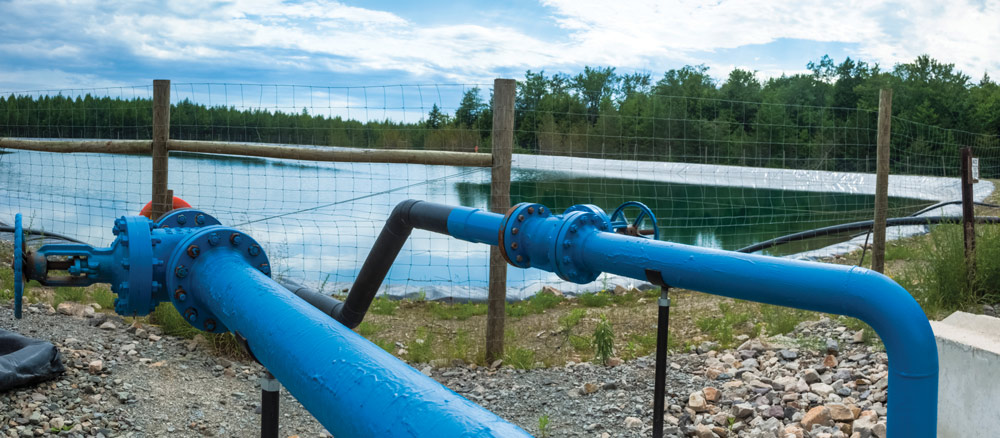
Seemingly miraculous innovations have made it possible to slake the ever-growing thirsts of our industrial society.
Need more energy? Frack it from deep-bedded rocks. Fresh water? Desalinate ocean flows. Precious metals? Leach them from low-grade ores that were previously un-minable.
But these and other marvels leave us in a pickle—awash in a sea of hypersaline brine. This “brine”—wastewater containing levels of salt several times higher than seawater and often contaminated with pollutants—is a byproduct of these and other industrial processes, and it’s a problem.
“The disposal of brine solutions with total dissolved solids greater than 60,000 mg l−1 poses technical, environmental and economic hurdles that remain mostly unresolved,” says Senior Research Scientist Arup SenGupta, a professor emeritus of civil and environmental engineering.
However, a new approach developed by SenGupta and visiting researcher Hao Chen ’23 PhD (then a doctoral student) represents a leap forward in cleaning up and even potentially unlocking valuable resources lurking in the super-salty water.
Brine’s dirty secrets
The current methods of managing hypersaline brine often exacerbate the environmental damage inherent in industrial processes. Coastal desalination plants commonly pump brine back into the ocean, disrupting deep-sea ecosystems in the process. Inland industrial facilities frequently rely on open-air evaporation pools (pictured above), a practice that is inefficient, weather-dependent, and capable of concentrating contaminants that threaten groundwater and surrounding environments. Pumping brine into deep wells within the earth, once a standard method, has been outlawed in many areas due to its ecological and geological risks.
Other approaches, such as multistage thermal distillation and membrane distillation, have certain advantages but come with significant drawbacks. These methods require large energy inputs to generate heat and are prone to scale buildup and irreversible fouling, or contamination of equipment.
In response to these challenges, developing methods for concentrating brine to levels conducive to the recovery of crystallized solids has become a priority for the U.S. Department of the Interior and global water agencies. Crystallized solids can more easily be disposed of or reused for industrial processes, or perhaps even “mined” for valuable materials such as lithium.
Crystallizing a solution
SenGupta and Chen have developed a new process called evaporative ion exchange (EIX), which concentrates brine at room temperature using air humidity and ion exchange to drive the process. Unlike existing methods, EIX avoids scaling and fouling and operates significantly faster than natural evaporation due tohigh surface area of the ion exchange resin beads. This innovation is detailed in a study recently published in the journal Nature Water.
The process uses a polymeric ion exchange resin bead—a gel-like material imbued with a high concentration of charged functional groups. These groups bind ions of opposite charge, enabling the beads to absorb water quickly while rejecting salts and other compounds. According to SenGupta, this phenomenon resembles forward osmosis, although no semipermeable membrane is involved. Instead, the ion exchanger-water interface acts as a semipermeable membrane, ensuring rapid water uptake.
When exposed to unsaturated air, the resin releases the absorbed water into the air through evaporation at room temperature, without the need for external heat input.
“This cycle can be repeated, allowing the resin to continuously concentrate solutions at ambient temperature,” SenGupta says, “The process is rapid, and the total energy requirement is provided by the ambient air.”
Testing the Waters
To test this approach, the researchers conducted experiments using both synthetic hypersaline brine and brine samples collected from gas well sites in the Pennsylvania and New Jersey Marcellus Shale region. The Marcellus brine contained high concentrations of barium, strontium, and calcium ions. In the experiments, EIX beads were placed in a bed, covered with brine until saturation, and drained. The beads were then exposed to blown, unheated air for evaporation. The remaining brine’s volume and total dissolved solids (TDS) were measured after each cycle.
After three cycles with synthetic brine, the volume was reduced by nearly threefold, and TDS increased by the same factor. By contrast, resin beads without ion exchange functional groups achieved less than a 20 percent increase in TDS. When applied to the Marcellus sample, the process achieved direct crystallization of salts such as barium chloride and sodium chloride after four cycles. These results were achieved without scaling or fouling of the resin, and the method showed potential for recovering lithium from naturally occurring hypersaline brine.
“The most remarkable finding of this study is the precipitation/crystallization of salts from the hypersaline water from a Marcellus gas well after four EIX cycles at ambient temperature,” says SenGupta. “According to the literature, no other brine concentration process attains incipient crystallization at ambient temperature.”
The study was funded by the U.S. Bureau of Reclamation, the Pennsylvania Infrastructure Technology Alliance, and a Lehigh faculty innovation grant.
Scaling the vision
SenGupta is optimistic about scaling the process for widespread use, citing its simplicity and efficiency. The next steps involve running a pilot system to validate process parameters and energy advantages over existing methods that require elevated temperatures.
“The EIX process does not need any specialty material to be manufactured for scale-up,” says SenGupta. “It does not need any heat or major energy source. It can be rapidly scaled up.”

